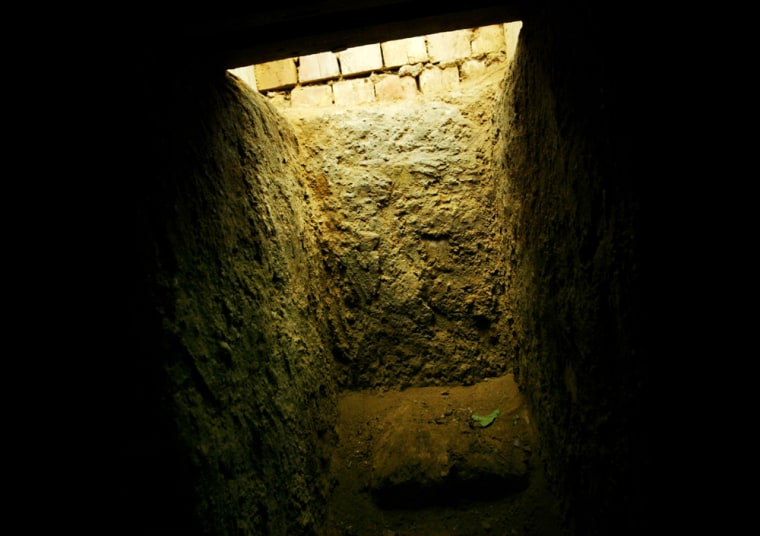The hole where Saddam Hussein was found hiding a year ago has not, as the U.S. military hoped, been filled in, and a two-room outhouse near the hideout is scrawled with pro-Saddam graffiti.
On the evening of Dec. 13 last year, a haggard and bearded Saddam was pulled from the “spider hole” on a farm south of his hometown of Tikrit and taken into U.S. custody.
A month later, forces from the U.S. 4th Infantry Division, who captured the former dictator, said they planned to fill in the hole to prevent it becoming a shrine.
“In order to avoid making it a tourist attraction and/or a shrine, we believe the best course of action is to eliminate it,” a military spokesman said at the time.
Styrofoam slab covers entry
But there was opposition to the idea from some Iraqi officials, who felt it was not up to the Americans to make such a decision, and a year later the hole, covered by a thick styrofoam slab with handles, remains unfilled.
A Reuters television crew visited on Sunday and were shown around by a man who refused to give his name but said he knew all about the last moments before Saddam’s capture.
He said a local man called Mohammed Ibrahim, who is not from the same tribe as Saddam but knew his family, had been the one to inform U.S. forces of the former president’s whereabouts.
On his tip, U.S. troops searched the farm, near the village of Ad Dawr, about 5 miles south of Tikrit on the banks of the Tigris, but found nothing. They went back to Ibrahim and asked what was going on.
Ibrahim took them back to the farm, the man said, and pointed out the hole in the ground, pulling back the cover and saying, “It’s all over Saddam, give yourself up!”
Saddam spat in Ibrahim’s face as he emerged from the hole, the unidentified man said.
U.S. mum on identity of tipster
The account cannot be independently verified. U.S. military commanders have not revealed who tipped them off to Saddam’s whereabouts that night a year ago.
The ramshackle shepherd’s shack near the hole, where troops discovered two beds, a refrigerator containing lemonade and hot dogs and an open box of Belgian chocolates, is now deserted.
Trash, including empty U.S. military ration packs, is piled up in the corners of the hut, where last year soldiers found a suitcase with $750,000 in $100 bills and boxes of shoes.
The outside of the building is scrawled with graffiti reading “Death to Traitors.”
In the nearby village of Owja, Saddam’s birthplace just outside Tikrit, several walls are decorated with graffiti reading “Long Live Abu Uday” and “Long Live Izzat al-Douri.”
Abu Uday, literally “Father of Uday” in a standard Arabic form of address, means Saddam. His sons Uday and Qusay were killed by U.S. soldiers in Mosul in July last year.
Top lieutenant still missing
Izzat Ibrahim al-Douri was one of Saddam’s most feared lieutenants and is one of the few close aides still eluding U.S. forces 20 months after Saddam was overthrown.
Asked about the hole on Sunday, a spokesman for U.S. forces in Tikrit said he thought it had been filled in, but then remembered that was merely the intention.
“I don’t know what’s been going on there,” the spokesman said. “Troops haven’t been out there for a while.”
